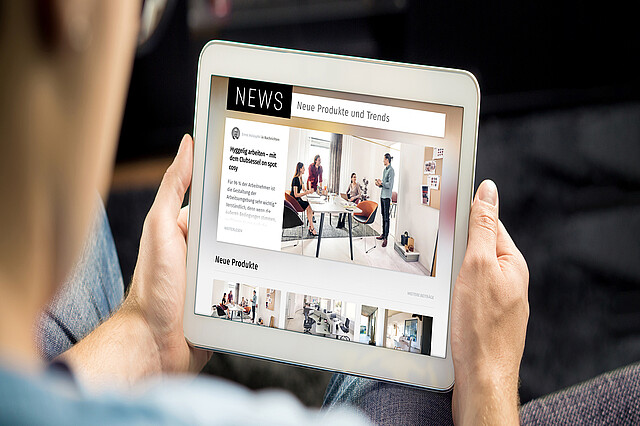It's not just the boundaries between working from home and the office that are becoming blurred. The working environment is also being reinterpreted. Employees are increasingly demanding to retain control, not only over working hours, but also over where they work.
In the current issue of Sedus INSIGHTS and the accompanying blog article, we asked the question, "To go or not to go? Why do people prefer to work in offices, or other locations?" and received a number of answers that also relate to the office workplace. One answer stands out in particular:
The right workplace: offices offer ergonomically designed workstations that are optimised for concentrated work and long working hours.
Ergonomics in the workplace
Ergonomics in the workplace is a key aspect that not only has a significant impact on productivity, but also on the well-being of employees. With desk sharing in particular, employees need desks and office chairs that can be easily adapted to their personal and physical needs. However, ergonomics not only includes the best position for the spine, but also lighting and background noise. The following points should help to create a workplace with a feel-good factor for all employees. These tips come from our ergonomics expert Michael Kläsener.
1. Customisable workstations
Make sure that workstations can be customised to meet the different needs of employees. In a hybrid office, adjustable desks and chairs are essential to enable an ergonomically correct sitting position. For all employees.
We recommend the black dot for sharing desks or alternating workstations. This office chair stands for durable quality, sophisticated design and numerous equipment options. Sitting for long periods places a great strain on the body. Mental performance also suffers as a result. The black dot provides flexibility, with Sedus dorsokinetics, and keeps people in balance. This relaxes the intervertebral discs and the neck and back muscles.
2. Encourage movement
"What actually makes us ill is that we get used to a static posture," says Michael Kläsener, ergonomics expert at Sedus. It is therefore advisable to integrate areas in the office that are suitable for short breaks and informal meetings. Encourage your employees to regularly change their position and move around.
Our practical examples of hybrid working environments in the office show how this can be achieved. Our swivel chair se:motion is ideal for this. Come, sit, do: se:motion does not require lengthy adjustment, it simply adapts itself to each user. The se:fit standing stool enables dynamic sitting and standing and thus promotes movement at the workplace.
3. Optimise lighting
"We have wonderful natural light when a workstation is close to the window. Otherwise, of course, you also have to take care of the lighting situation. It is still considered exemplary, and this is also stated in the DGUV guideline, if a distinction is made between path lighting and workplace lighting. Path lighting can be direct or indirect, it doesn't matter. Work area lighting is where people sit and work. Here you should take care to reduce glare effects," explains Michael Kläsener.
Provide sufficient natural light and supplement it with artificial lighting that can be customised. Avoid glare and reflections on screens to protect employees' eyes.
4. Improve acoustics
Good sound is not only important in interpersonal communication, but also for the ears. Sound plays a role here. This is easy to observe in open-plan offices. If there are many smooth surfaces, such as closed shelves, doors, windows or high ceilings, the room echoes enormously. This causes a background noise in the ear. Every sound echoes back and reverberates off the smooth surfaces. This creates an unpleasant noise level.
Sources of noise in the workplace should be minimised so that employees can concentrate. You can dampen the sound with carpeting, but acoustic panels also help to reduce reverberation and create a quiet working atmosphere.
5. Create opportunities for retreat
Provide quiet zones and retreats in the office that promote the well-being of employees. These areas enable relaxation and focused work. You can provide comfortable furniture and sophisticated room-in-room systems. Our solutions offer lounge furniture for relaxation moments, screened-off areas for focused work and discretion for confidential discussions. The products combine attractive design with functionality and ergonomic comfort to increase productivity.
6. Promote training and awareness
Train your employees regularly in ergonomic working and the correct use of office furniture. This will raise awareness of the importance of ergonomics in the workplace.
Ergonomic workstations are the key to a healthy and productive working environment. With the right furniture and solutions, every workplace can be designed to meet the individual needs of employees. Sedus offers a wide range of ergonomic products specifically designed to promote comfort and health in the workplace. Use these tips and Sedus solutions to optimise your office design and support your employees.
With many thanks to Michael Kläsener for his input for this article.

Read more from the Sedus trend monitor ‘INSIGHTS’ – Issue 18 looks at Workplace Blend
social media channels:


